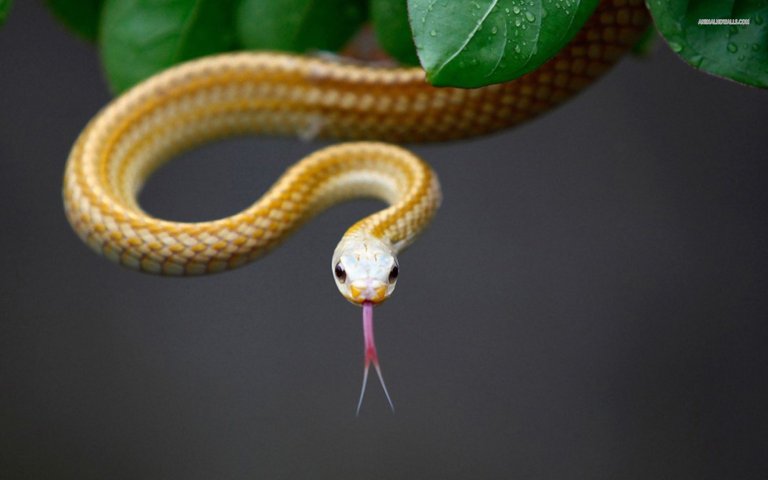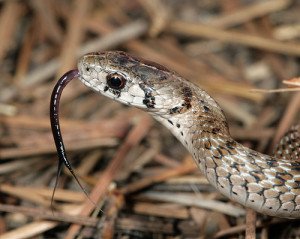If you ask someone to draw you a picture of a snake, there's a really good chance they will draw a forked tongue sticking out of its mouth. Pretty much everyone knows that all snakes (and some lizards!) have bizarre forked tongues that they flicker through the air as they slither around, but fewer understand exactly why. With tongues being fairly consistent in shape across the vertebrate animal kingdom, why are snakes' so drastically different?

If you go to the mirror and stick your tongue out, it will undoubtedly look something like this:

Humans, and most other vertebrate animals, have rounded tongues like the one pictured. It works pretty simply; the tongue is covered in taste buds which provide information to our brain about how something tastes. Sensitive microscopic hairs called microvilli will detect whether objects are sweet, sour, salty or bitter.
To understand why a snake's tongue is so different from your own, you have to know how they sense the world around them. Human beings rely primarily on sight and sound to identify things and people around them; at close distance we rely on our sense of touch, but we don't strongly rely on our sense of taste or smell. Snakes completely lack an outer ear and eardrum so hearing is completely out of the question (though they can detect some sound vibrations if loud/close enough). Their eyes do not focus particularly well; while they can make out certain shapes and moving objects, their sense of sight is quite limited. Even at close range, their sense of touch doesn't convey much information as they are covered in keratin scales. This leaves them heavily relying on their chemosensory systems, essentially taste and smell (and a few rely on heat-sensory organs, but this is not universal in snakes!).

It's well known that snakes essentially "smell" with their tongues, but the fact is, the tongue itself doesn't actually taste or smell. Unlike our taste bud-covered tongues, the tongues of snakes completely lack taste buds and smell receptors. Instead, they rely on a vomeronasal organ called the Jacobson's organ (you have one too!). Snakes have two holes in the roof of their mouths which open to the Jacobson's organ; it essentially performs the task our taste buds do, reading the chemical cues on the tongue. Every time a snake flicks its tongue, it is simply gathering chemical particles out of the air; snakes even have different flicking patterns for collecting different chemical signals. When the tongue is brought back into the mouth, it is placed against the Jacobson's organ which identifies the chemicals or pheromones that were picked up. The organ then sends signals through nerves into the olfactory bulbs in the snake's brain. This system allows snakes to find prey, keep track of their location and find a mate.

So why is the tongue forked? Tracking something by smell can be difficult; it's one thing to identify a scent, but it's another thing entirely to find the source...especially one on the move. In humans, our noses can't really detect the direction of a scent; if we want to locate the source, we actively move around to see where the aroma is stronger. The forked tongue of a snake is the perfect tool for locating the sources of these scents, primarily prey. As the tongue leave the mouth, the forks are spread wide. When the tongue returns to the Jacobson's organ, it can actually detect which tongue fork contains more of the chemical. If it's stronger on one side, the snake knows the direction it needs to go.

Just by looking at a snake or lizard, you can actually gauge how much it relies on this sense. The longer these forks are, the more the animal relies on them as it gains more directional information with each flick. In the photos below we see an iguana, which relies primarily on sight, has a weakly forked tongue, as opposed to the strongly forked tongue of a garter snake.


Image Links: 1, 2, 3, 4, 5, 6, 7,

This is very interesting. I always knew about the Jacobson's organ, but had no Idea about the reason the tongue was forked.
You're doing a lot of good here. I'm slowly getting desensitized to my phobia of snakes, in theory, not in practice yet. Do you think snakes will evolve to not have eyes at all in future evolution if they already seem to be more of a vestigal element to their practical anatomy? Nice topic today.
Awesome! Glad I can help!
I don't foresee snakes losing their eyes because they aren't quite vestigial. Though they may rely predominantly on chemosensory organs, and their eyes are far less effective, they are still able to see. Most snakes have reasonable vision during the day, and some even have reasonable nightvision. They can make out moving objects and will hunt visually, though they occasionally miss their target due to their inability to focus their eyes. Think of their sense of sight as being like our sense of touch; it's not our strongest sense, but we still rely on it a fair amount, more so than our sense on taste/smell.
There ARE however some snakes that are completely blind since they live underground. Since their eyes are vestigial, it's very likely they will disappear over time (some already have).
Absolutely fascinating stuff I never knew before! I'm so glad I came across your article, Thank You so much. ;)
We recently had a snake climb a tree in our yard, which surprised me quite a lot...
😄😇😄

Glad you found it interesting!
Are there any snakes with good eyesight?
Most have decent eyesight (barring blind snakes!), and do rely on sight for hunting. Some species even have slit pupils like a cat and have reasonably good night vision. But they can't focus their eyes as efficiently as we can, so their vision is somewhat limited compared to ours, hence why they rely more on chemosensory. If you approach a snake, chances are it can see you, but it'll probably flick its tongue to gather more information than it can by sight!
Cool, good to know!
Congratulations @herpetologyguy! You have completed some achievement on Steemit and have been rewarded with new badge(s) :
Click on any badge to view your own Board of Honor on SteemitBoard.
For more information about SteemitBoard, click here
If you no longer want to receive notifications, reply to this comment with the word
STOPI simply love your articles, what great content and quality of posting you offer the community here on Steemit and abroad.
Thanks a lot :)
That's so "clever" from father evolution's side. I have 1 question though, how accurate is it? Can snakes tell a general distance to the source of smell based on number of molecules or is it just a direction?
Interesting. Didn't know this. So it's the same logic as antennas I assume?
awesome post as usual :D
Really really nice information and great photos, thanks for sharing @herpetologyguy!
Nice article explaining forked tongue. I saw new contents. You really put effort in it. I feel educated. Thanks
Cute Cat Cubs...

Vote Please....
https://steemit.com/cat/@akhterhossain/animals-photograph